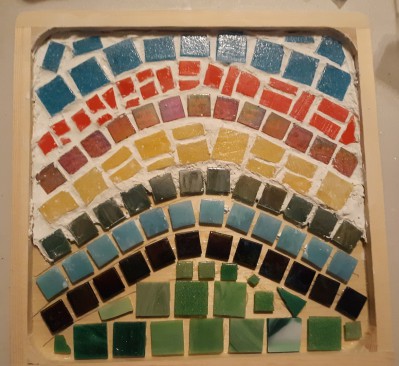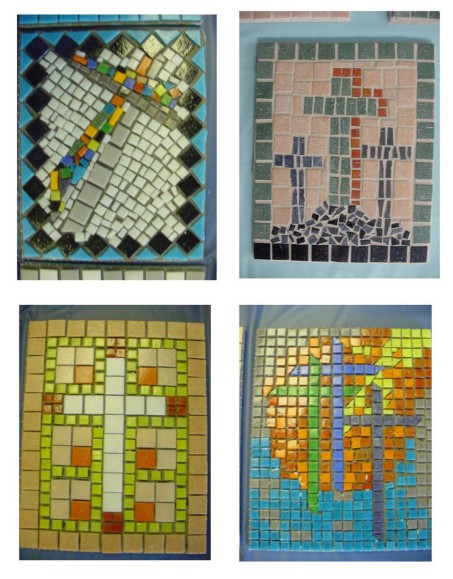
March 2022
March 25, 2022
Mosaic Creation 3
As I work to prepare for the Mosaic Workshop that we will hold in a little over a week, I also continue to reflect on the ways in which our lives are like a mosaic creation. Last week I shared a photo of the sample mosaic that I put together, one which is meant to demonstrate possibilities as well as to point out ways in which technique makes a big difference in the finished project. I also mentioned that it stood in contrast to the finished projects of a number of years ago, some of which are pictured in the previous week’s blog.
There are two main differences between the sample piece and the finished works from the previous workshop. The first is that the unfinished sample shows that I did not spend a whole lot of time creating it, and the large grout lines demonstrate the lack of attention to detail. On the other hand, the prior projects, while showing varying degrees of detail and complexity, all communicate the level of care and attention that they required. The finished projects are beautiful, each in their own way.
There is no quick way to create a beautiful mosaic project, just as there is no hurried way to create the beauty of our lives. To plan a mosaic creation, to carefully cut the glass pieces, to glue them into place, to step back and evaluate the emerging creation along the way, all require patience and focused attention. When we engage in such an act of creation, we have to slow down, and focus our attention solely on what is before us, and hopefully we will discover joy in the process of what we are doing.
In the same way, crafting our lives often means that we can benefit from slowing down. When we take the time to focus our attention, and to attend to what is going on, and how we want to grow through it, we can discover joy there too. We do have to stand back from all of our activities at times, and evaluate who we are and where we are headed. And then we can move back into the creative part of things, and continue to bring forth the beauty of our lives.
I don’t know that participants in the upcoming workshop will necessarily focus on the connections with their own lives. I expect that they will be concentrating on what they are doing with their mosaic creations. But I want to help them to see the connections at some point. I want this to be a part of their Lenten journey, and not just an art class. I hope that they will discover some joy in both parts of the journey.
March 18, 2022
Mosaic Creation 2
I closed last week by sharing an image of some of the finished projects from our mosaic workshop that we held a number of years ago. I also mentioned last week that I was experimenting with some new materials, trying them out before ordering for a workshop of people. So, let me first share with you an image of the sample project that I have been working on, which is not a finished, beautiful work, but rather it is intended to be a teaching tool, demonstrating options for people’s projects and providing a view toward better ways to do things.
The mosaic was created in a shallow wooden box, which is different than the base material from a few years ago, but which allows people to sense the edges of their works, and to have a frame against which to place their mosaic pieces and to do the grouting. I have only grouted part of the piece so that people can see the two basic stages of what they will be doing. I have also composed the piece with varying sizes and shapes of the mosaic glass, so that participants can readily see their options.
In a general sense, I would suggest that people choose a somewhat uniform size of glass to begin with, and to then make the cuts to conform to their chosen design. For example, in the red arc of glass, I would encourage them to either use all small pieces as on the left end, or to settle on the medium pieces, such as are seen on the right, as their chosen starting size. There is of course no right or wrong way to create their mosaics, and different sizes will likely be required in more complex projects, but while I did this sample as a demonstration piece, I do not find it to be particularly artistic and would not use such methods in a carefully created piece.
In the same way, how one places the pieces of glass, and then grouts them, depends upon the look that someone is hoping to achieve. I would actually suggest that people attach the pieces of glass more closely together so that their grout lines would be thinner and would emphasize the beauty of the glass. But my sample piece allows them to see the wider gaps for grout, and the pieces from the previous workshop will show them the look that thin grout lines will give them.
Finally, my goal is for people to enjoy the process, and to connect their experience with how our lives resemble the creation of a mosaic. If they emerge with something beautiful, that will be wonderful. But I am much more hopeful that they will simply come away with the joy of the experience.
March 11, 2022
A Mosaic Workshop
I mentioned a couple of weeks ago that I am planning to offer a mosaic workshop during this Lenten season. While people will be welcome to attempt either complex or simple projects, I will focus on simple ones for most people, and invite only those who have participated in workshops in the past to create more detailed mosaics.
As I said before, my hope is that through the creation of these mosaic projects, people will further experience the overall theme of the season, and consider the ways in which they create the mosaic of their lives, just as they will create the project that they choose in the workshop. Indeed, the emphasis will be on the process of the projects and what insights that may provide to us about the Lenten journey and our own growth. While I am certain that the projects will be beautiful because the glass itself is beautiful, I want to encourage people to enjoy the act of creation rather than worrying about any kind of perfect work of art.
I am exploring the logistics of this workshop, and I am experimenting with different materials than in the previous ones. The glass of course is the consistent material, but I am looking at different base materials, as well as grout that may be simpler for people to use. There is an investment in materials for a workshop such as this, but it is important to have ample supplies, so that while people can share, they also feel that they can work at their own pace without having to wait too long for a cutting tool or glue. The cutting tools are perhaps the most expensive portion of the supplies, and fortunately I have the tools from previous workshops. It isn’t necessary to have a cutting tool for each person, but the five that I have will accommodate a workshop of ten to fifteen people. And, importantly, I have protective glasses that go with each of the cutting tools. Even though the glass doesn’t splinter too much, it is still glass and safety is important. As to costs if you attempt such a workshop, you may need to charge a larger fee the first time, as you are accumulating tools, glasses and an inventory of glass, and perhaps paying an artist to assist you. Subsequent workshops though, such as the one I am offering this year, become much more cost effective and accessible to all.
As I close this week, I share with you an image of several of the projects that we did years ago, and in subsequent weeks I will share images of the project I am working on as I experiment with the materials.
March 4, 2022
The Journey Has Begun
Ash Wednesday is always a fascinating experience for me. When I grew up, in the same Disciples of Christ denomination, I clearly remember having Maundy Thursday observances, but I don’t recall a single Ash Wednesday service. In some ways that makes sense, both from the perspective of the centrality of communion in our tradition, and from the ways in which Protestant churches tended to distance themselves from practices that seemed more at home in Catholic churches.
And yet, I find our Ash Wednesday service to be particularly significant, both in the symbolism of the day and in having a distinct beginning to the Lenten season, as opposed to simply picking up the theme on the first Sunday of Lent. Of course, one of the deeply symbolic acts of the service is the imposition of ashes. I find it quite meaningful to offer this, and I am always pleasantly surprised by how many people come to receive the ashes.
We hold our service in the evening, following a soup supper, so the ashes are not on peoples’ foreheads all day, offering a testimony to their co-workers, friends and people they encounter in the market. But the ashes are nonetheless a significant statement for each individual as they begin their Lenten journey, and it is a marker of having begun an intentional walk through this season of growth and transformation.
The other prominent symbol in the sanctuary on Ash Wednesday is an artistically created cross. While this cross graces that wall of the worship space for most of the year, it takes on an added significance at the beginning of this journey. It speaks of the empty cross to which we are eventually headed, and of the glorious joy that comes when we arrive at the end of the journey.
The symbolism of Ash Wednesday is rich, and I imagine that other symbols of our journey will appear along the way as well. These images provide a profound message as they weave themselves into our hearts and minds amid the songs and scripture readings and sermons that will come. All of this together will provide an experience of Christ that will move within us and lead us to a fuller life.


